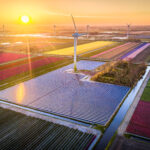Recently we’ve been enjoying the series Powering Britain on BBC iPlayer, from looking at wind farms to biomass energy generation, it’s given a great insight to those of us who don’t live and breathe energy and fascinating for us in energy to see behind the scenes of sites across the UK.
Britain’s weather power
The first episode features around wind energy generation, something we know a lot about from just looking outside our window we can see Walney Offshore Windfarm on a clear day spinning away generating energy.
The wind episode took us through the journey of safety and the build of the turbines, which as high as our Blackpool Tower, with blades as long as most commercial passenger planes through to the operation and generation of the turbines. You see insights into the ships that support the technicians and engineers through to how weather forecasting is vital to keep the turbines operating.
Hornsea wind farm off the coast of Yorkshire takes up as much space as 58,000 football fields in the ocean! And each turbine in Hornsea wind farm generates 7 megawatts of power, making the entire site generate over 1 gigawatt – the first wind farm in the world to generate that level of power, and they’re not stopping there with plans to generate over 6 gigawatts.
The team found it fascinating to see how Orsted’s offices physically change when storms are due within a set distance of the turbines!
But without the commitment from government and organisations to enable renewable energy generation, sites like Hornsea won’t continue to develop across the UK. That’s why CPPAs are a key function in enabling renewable energy, generation and green job creation.
From wind to nuclear green energy
From wind, we went on to watch all about splitting the atom with nuclear energy. Keeley Donovan visited Heysham based up the road from us on the north west of England. The plant provides 2.3gigawatt of energy for the national grid.
The complex nature of nuclear is explored, giving insights into how atom’s splitting forms heat and transformed into energy from steam. Looking back at the history of nuclear, radiation considerations when on site as well as the police presence for each nuclear site.
The Springfield nuclear facility creates the fuel for Heasham to produce energy to the equivalent of 12.5 million tonnes of coal in a year. Coal that was not burnt means natural resources weren’t used up and emissions going into our atmosphere.
However, both Hesham sites are due to be decommissioned in the coming years as they’re reaching their end of life. So, can nuclear be a part of the energy mix for the UK in the long run when it has a limited lifespan just like our finite natural resources used in energy production such as coal?
The 60s gas boom
The gas episode explored the boom in gas production from the North Sea since the 1960s. Classed as an ‘energy revolution’, and ‘abundant resource’, but is it everlasting? How does a platform recycle it into a wind turbine? Watch the episode to find out.
The show’s gas experts commented that it’ll still be in use for at least 3-4 decades citing that renewable generation can’t support the UK’s energy demands. Yet how would continuing to use gas impact the UK’s net zero goals.
Transitioning from coal to biomass
Drax, featured in the Biomass episode, was once dubbed the most polluting power station in Britain, but it’s started to turn from coal to biomass power with 1600 tonnes of biomass fuel delivered by trains each week to burn into power – trains that don’t even stop when they drop the fuel off!
The biomass energy episode goes into detail of how the biomass cargo is transformed from pellets to energy, which can power several of the UK’s cities for many days from just one of the massive storage tanks, as well as going behind the scenes of the boilers and towers creating the energy.
But what about the climate and green jobs?
What the series misses is the longevity of the different energy production methods, how we can store the energy for unplanned peaks to create instant demand to meet what Andy Murray caused, as well as the pros and cons of them against each other.
Given the rise in climate knowledge, where the BBC’s own programmes such as Gardeners’ World are commenting on the climate change and its effect on plant and vegetable growing conditions, it would have been prudent to comment on this aspect of the energy production. It would have given a great opportunity to explore the green education and the growing green jobs market.
If you’d like to explore more about switching your organisation’s energy to a green solution, then our renewable energy and risk management team can help you through the process and you’ll be helping support a green energy revolution, both commercially and for future next generations.







